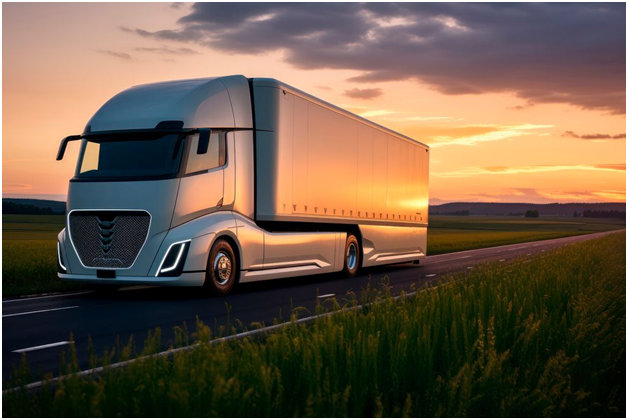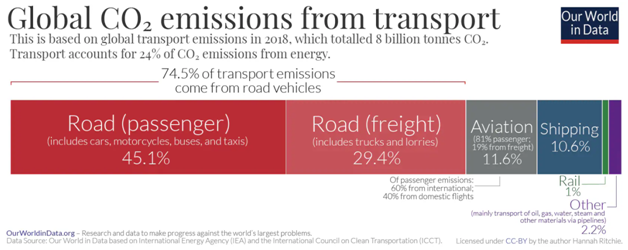
While passenger vehicles contribute to approximately 45 percent of the global CO2 emissions in the transportation sector, the second-largest percentage (29 percent) is attributed to freight shipping (Figure 1).[1] Furthermore, as diesel is the primary fuel, it also serves as a significant source of other harmful pollutants, including particulates and nitrogen oxides, which can seriously impact the environment and people’s health.

Similar to the changes seen in the world of passenger vehicles, significant shifts in the underlying technologies and deployment of commercial transportation are needed to help increase sustainability.
Electric Trucks
Commercial vehicle manufacturers have come together to form the European Automobile Manufacturers’ Association (ACEA). The ACEA, along with scientists from the Potsdam Institute for Climate Impact Research (PIK), has established a roadmap for becoming carbon neutral by 2050.
According to ACEA, registrations for electric heavy goods vehicles (HGVs) increased by 32.8 percent in 2022 compared to 2021. But this still represents only 0.6 percent of new vehicles being electrically charged.[2] For mass adoption, there are several technical challenges to overcome, including the following:
- Limited driving range – Existing batteries lack the power density for many commercial applications.
- Adequate charging infrastructure – More and higher-capacity chargers are required.
- Battery mass vs battery capacity – Large batteries reduce payload capacity for long-haul trucks, but smaller batteries increase delivery times due to more frequent charging.
Charging the large batteries in trucks in a reasonable time requires the development of megawatt chargers. Companies are cooperating on standards for future ultra-fast, megawatt charging, such as the Megawatt Charging System (MCS).
Thicker and heavier cables are also required for higher power, presenting design and usability challenges. For example, connectors and cables will need liquid cooling, and megawatt charging stations must address the impact of load swings caused by trucks charging on the grid.
Alternative Charging Methods
To alleviate the requirement for megawatt charging stations, commercial vehicle manufacturers are considering other solutions.
Overhead catenary charging could allow trucks to charge while driving by taking power from an overhead cable via a pantograph. However, such a solution would need to be complementary to charging stations, as it would not be practical to electrify the entire road network.
Wireless charging would also allow vehicles to be charged while driving via electric coils buried in the road. This technology is in early research due to significant technical, cost, and safety challenges, as well as low efficiency.
Battery swapping is much faster than charging and can be as quick as 5 minutes. This time saving is particularly valuable for commercial vehicles where, literally, time is money. In China, almost half the electric trucks sold in 2022 supported battery swapping.[3] However, there are challenges associated with battery swapping, including the cost of additional batteries and the equipment for handling them, as truck batteries typically weigh about 3 tons.
Autonomous Vehicles
Autonomous electric vehicles are already used in constrained environments, such as warehouses, ports, and roads with no pedestrian access.
As well as lowering costs, self-driving trucks can address the shortage of drivers. They also remove the need for mandatory rest time—meaning vehicles can be in use for longer periods—and allow for more flexibility for charging stops, aiding the transition to electric power.
Einride is one company that has developed autonomous electric trucks (Figure 2). These are designed to be monitored by a remote operator at a fixed location. The operator can then take over control in certain situations, such as on narrow roads or at busy distribution hubs, and there is no requirement to travel long distances away from home.

Shipping
Per unit of freight moved, ships are a very energy-efficient way of transporting goods compared to trains, trucks, and trains. However, due to the scale of ship-based operations, the industry still contributes significantly to global CO2 emissions. Therefore, new innovations that could increase sustainability are being explored.
Perhaps the most obvious alternative source of energy for ships is wind. It has been used for centuries, but modern technology offers many options for much greater efficiency. Apart from traditional sails, one of the more innovative options is wing sails.
Projects like the combined BAR Technologies and Yara Marine WindWings initiative (Figure 3) and Oceanbird are developing wing sail ships. These structures are more akin to vertical airplane wings than traditional sails, with their rigidity enabling finer control and greater efficiency than traditional sails. In a typical system, the wind sails are mounted on the deck but can fold flat to enter ports or pass under bridges. They can also be retrofitted to existing vessels or included in new builds.

BAR Technologies and Yara Marine WindWings offer dynamic multi-element wings combined with route optimization, which can increase the fuel efficiency of existing vessels by as much as 30 percent,[4] while Oceanbird’s simulations have estimated their bespoke ships could reduce emissions by 90 percent.[5]
Conclusion
While increasing the sustainability of passenger cars is arguably being resolved by one primary initiative—the electrification of the powertrain—improving sustainability across commercial applications is going to need a range of innovative technologies tailored to each unique industry.
From high-performance or even road-based charging infrastructure to increased autonomy and cutting-edge sailing ships, manufacturers around the world are presenting an exciting range of solutions that can help create a sustainable commercial transport system.
References
[1] Hannah Ritchie, “Cars, planes, trains: where do CO2 emissions from transport come from?” October 6, 2020, https://ourworldindata.org/co2-emissions-from-transport.
[2] “Fuel Types of New Trucks: Electric 0.6%, Diesel 96.6% Market Share Full-Year 2022,” ACEA, March 8, 2023, https://www.acea.auto/fuel-cv/fuel-types-of-new-trucks-electric-0-6-diesel-96-6-market-share-full-year-2022/.
[3] Hongyang Cui, Yihao Xie, and Tianlin Niu, “China Is Propelling Its Electric Truck Market by Embracing Battery Swapping,” International Council on Clean Transportation, August 9, 2023, https://theicct.org/china-is-propelling-its-electric-truck-market-aug23/.
[4] “BARTech & Yara Partner to Bring WindWings to Global Market,” BAR Technologies, accessed January 10, 2024, https://www.bartechnologies.uk/insights/bartech-yara-marine-partner-to-bring-windwings-to-global-market/.
[5] “Why We Claim a 90% Reduction of Emissions,” The Oceanbird, blog, September 23, 2021, https://www.theoceanbird.com/blog/why-we-claim-a-90-reduction-of-emissions/.
Source: Mouser Electronics






